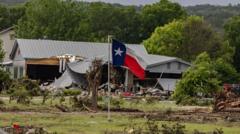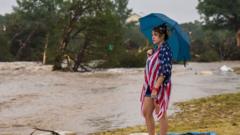In the wake of the deadly floods in Texas, discussions arise regarding the potential impact of staffing cuts at the National Weather Service under the Trump administration. While some experts raise concerns about communication inefficiencies, others assert that forecasts and warnings were adequate and timely.
Texas Floods: Did Government Cuts Impact Forecasting Accuracy?

Texas Floods: Did Government Cuts Impact Forecasting Accuracy?
A look into whether staffing reductions at the National Weather Service contributed to the tragic Texas floods, amidst conflicting reports from experts and officials.
In the aftermath of the devastating floods in Texas, a debate has emerged about the role of staffing cuts at the National Weather Service (NWS) under the Trump administration. Senator Chris Murphy has pointed to these reductions, arguing that diminished federal resources, including meteorologists, have "consequences" for effective weather forecasting. In his view, accurate forecasting is vital in preventing catastrophic disasters like the recent floods.
However, White House Press Secretary Karoline Leavitt countered these claims, stating, "These offices [of the NWS] were well staffed… so any claims to the contrary are completely false.” BBC Verify conducted a thorough examination regarding how previous cuts may have affected the NWS, concluding that, although staffing levels have decreased, they were sufficient during the flooding crisis.
Regarding the cuts, a proposed budget reduction of 25% to the National Oceanic and Atmospheric Administration’s (NOAA) budget of $6.1 billion will not be realized until the 2026 financial year, hence they did not play a part in the floods. Still, over the last few years, the NWS has seen a reduction in its workforce, attributable to an efficiency initiative that allowed for voluntary redundancy and retirements. Inclusive of turnover, the NWS lost approximately 600 employees from its 4,200 staff, leading to marked vacancies across various offices.
Despite these reductions, experts assert that the NWS's performance during the Texas floods was commendable. Avantika Gori, an assistant civil and environmental engineering professor at Rice University, noted, "The forecasts and warnings all played out in a normal manner,” citing the unpredictability of the extreme rainfall as the primary challenge.
Some experts speculate, however, that staffing shortages may have affected the coordination between NWS offices and local emergency services. Climate scientist Daniel Swain raised concerns about whether the communication of weather information could have been more effective, suggesting staff cuts impacted operational readiness in affected local offices.
It is reported that both the San Angelo and San Antonio NWS offices had existing vacancies during the floods, including a senior hydrologist and a warning coordinating meteorologist. Still, NWS spokesperson Erica Grow Cei clarified that additional personnel were mobilized in anticipation of the catastrophic weather, affirming that forecasts and warnings were issued promptly.
Concerning weather balloon launches, which are crucial for atmospheric data gathering, meteorologist John Morales referenced a national reduction in weather balloon releases. NWS confirmed that at some locations this was due to staffing shortages. Nevertheless, near the flood zones in Texas, weather balloon operations were conducted without interruption, suggesting they did not impede forecasting capabilities.
As discussions continue around the Texas floods and federal budget cuts, it remains crucial to piece together the roles of forecasting accuracy and resource management in navigating future weather-related disasters.





















